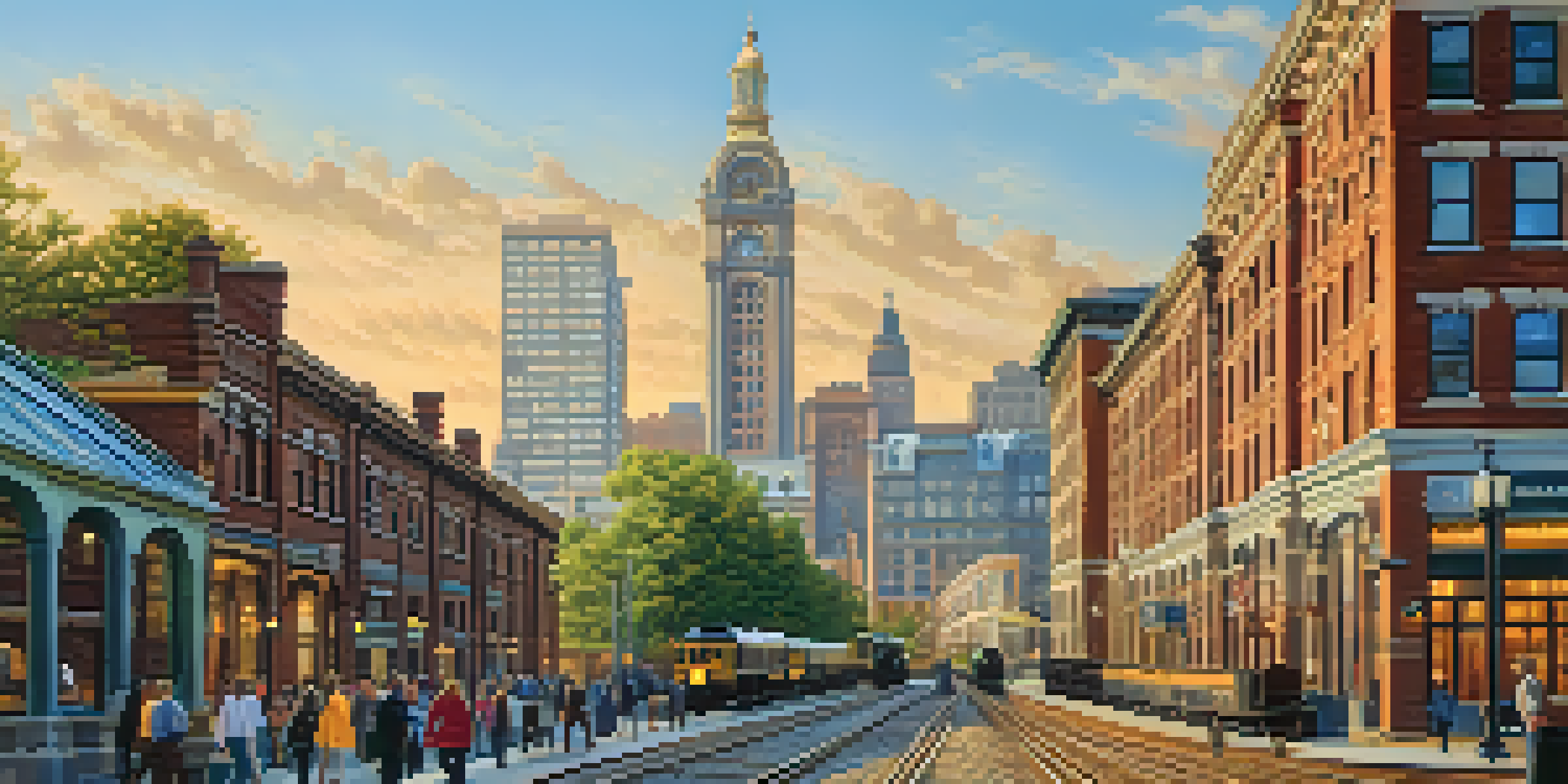The Impact of Industrialization on Jersey City's Historic Sites

Understanding Jersey City's Industrial Roots
Jersey City has a rich history that intertwines with the rise of industrialization. In the late 19th century, the city transformed into a bustling hub for manufacturing and shipping, driven by its prime location on the Hudson River. This shift not only attracted businesses but also a growing population, which contributed to the city's dynamic cultural landscape.
Preservation of historic places is not a matter of nostalgia, but a matter of identity and belonging.
The influx of factories and docks created a vibrant economy, but it also led to significant changes in the urban environment. Historic sites like the Central Railroad of New Jersey Terminal became vital for transporting goods and people, showcasing the importance of industrial progress. As the city evolved, these sites began to reflect the duality of growth and change.
Today, understanding Jersey City's industrial roots helps us appreciate the complexity of its historic sites. They serve as reminders of both the economic booms and the societal challenges that accompanied industrialization, making them essential components of the city’s narrative.
Preserving Historic Sites Amidst Urban Growth
As Jersey City embraced industrialization, many historic sites faced the threat of neglect or destruction. The rapid growth of factories and housing often overshadowed these landmarks, raising concerns about preservation. Advocates for historical preservation recognized the need to protect these sites, seeing them as vital links to the city's past.

Efforts to preserve places like the Jersey City Historic Downtown and the Liberty State Park have been crucial in maintaining the city's heritage. These locations not only provide insight into the past but also serve as recreational spaces for residents and tourists alike. Balancing development with preservation has become a central theme in Jersey City's evolution.
Jersey City's Industrial Heritage
The city's industrial roots have shaped its cultural landscape and architectural identity.
The challenge remains: how can a city that thrives on growth honor its history? By integrating historic preservation into urban planning, Jersey City strives to keep its past alive while accommodating the needs of a modern metropolis.
The Transformation of Architectural Styles
Industrialization brought about a significant shift in architectural styles across Jersey City. The need for functional buildings led to the rise of warehouses, factories, and other structures that prioritized utility over aesthetics. This shift created a unique architectural landscape, blending industrial designs with the city's earlier Victorian influences.
History is not a burden on the memory but an illumination of the spirit.
As time passed, many industrial buildings were repurposed, giving rise to a new wave of architectural innovation. For instance, the conversion of old factories into lofts and commercial spaces showcases a creative adaptation of historic structures. These transformations not only preserve the physicality of the buildings but also breathe new life into the community.
Today, walking through Jersey City offers a visual narrative of its industrial past, where modernity and history coexist. The architectural diversity tells a story of adaptation, resilience, and the ongoing dialogue between the old and the new.
Economic Impacts on Historic Preservation
The economic boom brought by industrialization had a profound effect on Jersey City’s historic preservation efforts. As new industries emerged, the focus often shifted towards immediate economic gains rather than long-term heritage conservation. This prioritization created a tug-of-war between development and preservation, reflecting broader trends seen in many urban areas.
However, as the importance of tourism and cultural heritage became more recognized, the tides began to turn. Efforts to revitalize historic areas have proven economically beneficial, attracting visitors and fostering local businesses. This shift underscores the notion that preserving history can also bolster economic growth.
Balancing Growth and Preservation
Efforts to preserve historic sites are crucial as Jersey City navigates urban development and economic growth.
Today, Jersey City's leaders and residents increasingly recognize that a commitment to preserving historic sites can lead to sustainable economic development. By valuing their heritage, they can create a thriving community that honors its past while looking toward the future.
Community Engagement in Preservation Efforts
Community engagement plays a pivotal role in the preservation of Jersey City's historic sites. Local residents often serve as passionate advocates for their neighborhoods, rallying support for preservation initiatives. Their voices are essential in highlighting the significance of these sites and ensuring that they are included in urban planning discussions.
Events such as historical walking tours and community meetings foster awareness and appreciation for Jersey City's history. These initiatives not only educate residents about their local heritage but also encourage them to take an active role in safeguarding it. Engaging the community helps create a sense of ownership over the city's historic narrative.
Ultimately, the success of preservation efforts hinges on collaboration among residents, local organizations, and government entities. When the community is involved, the preservation of historic sites becomes a shared mission, strengthening the bonds of identity and pride that define Jersey City.
The Role of Technology in Preservation
In recent years, technology has emerged as a powerful ally in the preservation of Jersey City's historic sites. Digital tools like 3D mapping and virtual reality allow for more effective documentation and analysis of these structures. This technological integration not only enhances preservation efforts but also makes history accessible to a broader audience.
Moreover, social media plays a significant role in raising awareness about preservation initiatives. Local groups often share stories, photos, and updates, engaging both residents and visitors in the conversation about the importance of maintaining historic sites. This digital outreach fosters a sense of community and encourages participation in preservation efforts.
Community's Role in Preservation
Active community engagement is essential for safeguarding Jersey City's historic sites and fostering local pride.
As technology continues to evolve, its role in historic preservation will likely grow. By harnessing these innovations, Jersey City can enhance its efforts to celebrate and protect its unique heritage while making it relevant to future generations.
Looking Ahead: The Future of Jersey City's Historic Sites
The future of Jersey City's historic sites hinges on a delicate balance between development and preservation. As the city continues to grow and evolve, maintaining its historical identity will be crucial. This challenge presents an opportunity for innovative approaches that integrate modern needs with respect for the past.
Community involvement, technological advancements, and supportive policies will all play vital roles in shaping the future of these sites. By fostering a culture of preservation, Jersey City can ensure that its rich history remains a central part of its identity, even amid rapid change.

Ultimately, the journey forward will require collaboration among residents, businesses, and government officials. By working together, they can create a future where Jersey City's historic sites are cherished, celebrated, and integrated into the vibrant life of the city.